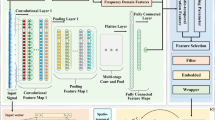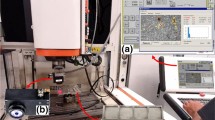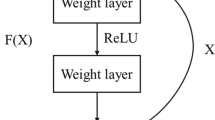Abstract
The importance of surface finishing processes and accurate surface quality prediction models has increased in response to the growing demand for improved surface finish in ultra-precision applications. To enhance process efficiency and develop accurate predictive models, numerous studies have investigated the monitoring and prediction of surface roughness. However, existing mathematical approaches encounter challenges in establishing the correlation between input and output variables and providing real-time surface status monitoring. Therefore, this study aimed to monitor and predict surface roughness in real-time for the rotational electro-magnetic finishing (REMF) process using acoustic emission (AE) signals. First, a total of 72 fundamental experiments were conducted based on the mixed orthogonal array L18(21\(\times\) 34) to determine the optimal configuration for achieving a high-quality surface. The results revealed that the best combination was achieved with an abrasive length of 3.0 mm, an abrasive diameter of 0.7 mm, a total abrasive weight of 2.0 kg, a rotational speed of 1800 rpm, and a working time of 10 min. To analyze signal features and develop an accurate surface prediction model, a convolutional neural network (CNN) was suggested, utilizing scalogram images as time–frequency characteristics of AE signals. The suggested model demonstrated outstanding quantitative results compared to those of the regression model, with training coefficient of determination (R2), mean squared error (MSE), and F-test of 0.986, 0.19\(\times\) 10−3, and 99%, and testing R2, MSE, and F-test of 0.951, 2.23\(\times\) 10−3, and 99%, respectively. In addition, the suggested model showed good generalization ability with a relatively lower mean MSE of 0.003 through verification experiments. These results demonstrated that the sensory data and image-driven model were effective in real-time monitoring and surface roughness prediction in the REMF process with high accuracy and reliability.













Similar content being viewed by others
Data availability
All the data supporting the results of this study were available within the article.
References
Liu J, Lu E, Yi H, Wang M, Ao P (2017) A new surface roughness measurement method based on a color distribution statistical matrix. Measurement 103:165–178. https://doi.org/10.1016/j.measurement.2017.02.036
Arora K, Singh AK (2021) Theoretical and experimental investigation on surface roughness of straight bevel gears using a novel magnetorheological finishing process. Wear 476:203693. https://doi.org/10.1016/j.wear.2021.203693
Medeossi F, Sorgato M, Bruschi S, Savio E (2018) Novel method for Burrs quantitative evaluation in micro-milling. Precis Eng 54:379–387. https://doi.org/10.1016/j.precisioneng.2018.07.007
Xing B, Zou Y (2020) Investigation of finishing aluminum alloy A5052 using the magnetic abrasive finishing combined with electrolytic process. Machines 8(4):78. https://doi.org/10.3390/machines8040078
Wei H, Gao H, Wang X (2019) Development of novel guar gum hydrogel based media for abrasive flow machining: shear-thickening behavior and finishing performance. Int J of Mech Sci 157:758–772. https://doi.org/10.1016/j.ijmecsci.2019.05.022
Ming W, Shen F, Zhang Z, Huang H, Du J, Wu J (2020) A comparative investigation on magnetic field-assisted EDM of magnetic and non-magnetic materials. Int J Adv Manuf Technol 109:1103–1116. https://doi.org/10.1007/s00170-020-05653-8
Wang C, Cheung CF, Ho LT, Yung KL, Kong L (2020) A novel magnetic field-assisted mass polishing of freeform surfaces. J Mater Process Technol 279:116552. https://doi.org/10.1016/j.jmatprotec.2019.116552
Zhang Z, Cui J, Wang B, Wang Z, Kang R, Guo D (2017) A novel approach of mechanical chemical grinding. J Alloy Compd 726:514–524. https://doi.org/10.1016/j.jallcom.2017.08.024
Basha SM, Venkaiah N, Sankar MR (2023) Development and performance evaluation of galactomannan polymer based abrasive medium to finish atomic diffusion additively manufactured pure copper using abrasive flow finishing. Addit Manuf 61:103290. https://doi.org/10.1016/j.addma.2022.103290
Azami A, Azizi A, Khoshanjam A, Hadad M (2020) A new approach for nanofinishing of complicated-surfaces using rotational abrasive finishing process. Mater and Manuf Process 35(8):940–950. https://doi.org/10.1080/10426914.2020.1750631
Liu J, Zhang Z, Shi C, Ren Z, Feng J, Zhou H, Liu Z, Meng F, Zhao S (2023) Novel green chemical mechanical polishing of fused silica through designing synergistic CeO2/h-BN abrasives with lubricity. Appl Surf Sci 637:157978. https://doi.org/10.1016/j.apsusc.2023.157978
Li Y, Zhang Z, Yang J, Ren Z Zhao S (2023) A novel green waterless and oilless chemical mechanical polishing for soft-brittle, temperature-sensitive and deliquescent potassium dihydrogen phosphate. Surfaces and Interfaces 103117. https://doi.org/10.1016/j.surfin.2023.103117
Xie W, Zhang Z, Liao L, Liu J, Su H, Wang S, Guo D (2020) Green chemical mechanical polishing of sapphire wafers using a novel slurry. Nanoscale 12(44):22518–22526. https://doi.org/10.1039/D0NR04705H
Zhang Z, Cui J, Zhang J, Liu D, Yu Z, Guo D (2019) Environment friendly chemical mechanical polishing of copper. Appl Surf Sci 467:5–11. https://doi.org/10.1016/j.apsusc.2018.10.133
Zhang Z, Liao L, Wang X, Xie W, Guo D (2020) Development of a novel chemical mechanical polishing slurry and its polishing mechanisms on a nickel alloy. Appl Surf Sci 506:144670. https://doi.org/10.1016/j.apsusc.2019.144670
Liao L, Zhang Z, Meng F, Liu D, Wu B, Li Y, Xie W (2021) A novel slurry for chemical mechanical polishing of single crystal diamond. Appl Surf Sci 564:150431. https://doi.org/10.1016/j.apsusc.2021.150431
Cui X, Zhang Z, Yu S, Chen X, Shi C, Zhou H, Meng F, Yu J, Wen W (2023) Unprecedented atomic surface of silicon induced by environmentally friendly chemical mechanical polishing. Nanoscale 15(21):9304–9314. https://doi.org/10.1039/D3NR01149F
Zhang Z, Wang X, Meng F, Liu D, Huang S, Cui J, Wang J, Wen W (2022) Origin and evolution of a crack in silicon induced by a single grain grinding. J Manuf Processes 75:617–626. https://doi.org/10.1016/j.jmapro.2022.01.037
Fan Z, Tian Y, Zhou Q, Shi C (2020) Enhanced magnetic abrasive finishing of Ti–6Al–4V using shear thickening fluids additives. Precision eng 64:300–306. https://doi.org/10.1016/j.precisioneng.2020.05.001
Karthikeyan S, Mohan B, Kathiresan S, Anbuchezhiyan G (2021) Effect of process parameters on machinability, hemocompatibility and surface integrity of SS 316L using R-MRAFF. J Market Res 15:2658–2672. https://doi.org/10.1016/j.jmrt.2021.09.060
Lin WJ, Lo SH, Young HT, Hung CL (2019) Evaluation of deep learning neural networks for surface roughness prediction using vibration signal analysis. Appl Sci 9(7):1462. https://doi.org/10.3390/app9071462
Xu G, Zhang Z, Meng F, Liu L, Liu D, Shi C, Cui X, Wang J, Wen W (2023) Atomic-scale surface of fused silica induced by chemical mechanical polishing with controlled size spherical ceria abrasives. J Manuf Processes 85:783–792. https://doi.org/10.1016/j.jmapro.2022.12.008
Caja-García J, Sanz-Lobera A, Maresca P, Fernández-Pareja Wang C (2018) Some considerations about the use of contact and confocal microscopy methods in surface texture mearuement. Meterials 11(8):1484. https://doi.org/10.3390/ma11081484
Ghodrati S, Mohseni M, Kandi SG (2019) Application of image edge detection methos for precise estimation of the standar surface roughness parameter: polypropylene/ethylene-propylene-diene-monomer blend as a case study. Measurement 138:80–90. https://doi.org/10.1016/j.measurement.2019.02.033
Gong Y, Xu J, Buchanan RC (2018) Surface roughness: a review of its measurement at micro-/nano-scale. Physical Sci Reviews 3(1):20170057. https://doi.org/10.1515/psr-2017-0057
Zou Y, Xie H, Zhang Y (2020) Study on surface quality improvement of the plane magnetic abrasive finisihing process. Int J of Adv Manuf Technol 109(7):1825–1839. https://doi.org/10.1007/s00170-020-05759-z
Jiao A, Zhang G, Liu B, Liu W (2020) Study on improving hole quality of 7075 aluminum alloy based on magneticabrasive finishing. Adv Mech Eng 12(6):687814020932006. https://doi.org/10.1177/1687814020932006
Singh M, Singh AK (2021) Magnetorheological finishing of variable diametric external surface of the tapered cylindrical workpieces for functionality improvement. J Manuf Process 61:153–172. https://doi.org/10.1016/j.jmapro.2020.10.074
Baraman A, Das M (2018) Magnetic field assisted finishing process for super-finished Ti alloy implant and its 3D surface characterization. J Micromanuf 1(2):154–169. https://doi.org/10.1177/2516598418785506
Ghosh G, Sidpara A, Bandyopadhyay PP (2021) Theoretical analysis of magnetorheological finishing of HVOF sprayed WC-Co coating. Int J Mech Sci 207:106629. https://doi.org/10.1016/j.ijmecsci.2021.106629
Zhuang X, Lu M, Zhou J, Lin J, Li W (2022) Improved magnetorheological finishing process with arc magnet for borosilicated glass. Mater Manuf Processes 37(4):458–466. https://doi.org/10.1080/10426914.2021.2006222
Guo J, Feng W, Jong HJH, Suzuki H, Kang R (2020) Finishing of rectangular microfeatures by localized vibration-assisted magnetic abrasive polishing method. J Manuf Processes 49:204–213. https://doi.org/10.1016/j.jmapro.2019.11.026
Prakash C, Singh S, Pramanik A, Basak A, Królczyk G, Bogdan-Chudy M, Wu YL, Zheng HY (2021) Experimental investigation into nano-finishing of -TNTZ alloy using magnetorheological fluid magnetic abrasive finishing process for orthopedic applications. J Mater Research and Technol 11:600–617. https://doi.org/10.1016/j.jmrt.2021.01.046
Wang Y, Wang Y, Zheng L, Zhou J (2022) Online surface roughness prediction for assembly intefaces of vertical tail integrating tool wear under variable cutting parameters. Sensor 22(5):1991. https://doi.org/10.3390/s22051991
Zhang X, Zheng Y, Suresh V, Wang S, Li Q, Li B, Qin H (2020) Correlation approach for quality assurance of additive manufactured parts based on optical metrology. J Manf Process 53:310–317. https://doi.org/10.1016/j.jmapro.2020.02.037
Li Z, Wang G, He G (2018) Surface quality monitoring based on time-frequency features of acoustic emission signals in end milling Inconel-718. Int J Adv Manuf Technol 96:2725–2733. https://doi.org/10.1007/s00170-018-1773-8
Ahmed YS, Arif AFM, Veldhuis SC (2020) Application of the wavelet transform to acoustic emission signals for built-up edge monitoring in stainless steel machining. Measurement 154:107478. https://doi.org/10.1016/j.measurement.2020.107478
Kishawy HA, Hegab H, Umer U, Mohany A (2018) Application of acoustic emissions in machining processes: analysis and critical review. Int J Adv Manuf Technol 98:1391–1407. https://doi.org/10.1007/s00170-018-2341-y
Mahfouz IA (2021) Machine learning acoustic emission based monitoring of cold forging for smart manufacturing: a review. Int J of Eng and Technol 2(3):77–80
Yang Z, Yan W, Jin L, Li F, Hou Z (2020) A novel feature representation method based on original waveforms for acoustic emission signals. Mech Syst Sign Process 135:106365. https://doi.org/10.1016/j.ymssp.2019.106365
Vicuña CM, Höweler C (2017) A method for reduction of acoustic emission(AE) data with application in machine failure detection and diagnosis. Mech Syst Sign Process 97:44–58. https://doi.org/10.1016/j.ymssp.2017.04.040
Pham MT, Kim JM, Kim CH (2021) 2D CNN-based multi-output diagnosis for compound bearing faults under variable rotational speeds. Machines 9(9):199. https://doi.org/10.3390/machines9090199
König F, Sous C, Chaib AO, Jacobs G (2021) Machine learning based anomaly detection and classification of acoustic emission events for wear monitoring in sliding bearing system. Tribo Int 155:106811. https://doi.org/10.1016/j.triboint.2020.106811
Zhang X, Lu X, Li W, Wang S (2021) Prediction of the remaining useful life cutting tool using the Hurst exponent and CNN-LSTM. Int J Adv Manuf Technol 112:2277–2299. https://doi.org/10.1007/s00170-020-06447-8
Xin H, Cheng L, Diender R, Veljkovic M (2020) Fracture acoustic emission signals identification of stay caalbes in bridge engineering application using deep transfer learning and wavelet analysis. Adv Bridg Eng 1:1–16. https://doi.org/10.1186/s43251-020-00006-7
Khan A, Sohail A, Zahoora U, Qureshi AS (2020) A survey of the recent architectures of deep convolutional neural networks. Artif Intell Rev 53:6566–5516. https://doi.org/10.1007/s10462-020-09825-6
Rifai AP, Aoyama H, Tho NH, Dawal SZM, Masruroh NA (2020) Evaluation of turned and milled surfaces roughness using convolutional neural network. Measurement 161:107860. https://doi.org/10.1016/j.measurement.2020.107860
Yamashita R, Nishio M, Do RKG, Togashi K (2018) Convolutional neural networks: an overview and application in radiology. Insights Imaging 9:611–629. https://doi.org/10.1007/s13244-018-0639-9
Miccio LA, Schwartz GA (2020) From chemical structure to quantitative polymer properties prediction through convolutional neural networks. Polymer 193:122341. https://doi.org/10.1016/j.polymer.2020.122341
Abbasi AA, Hussian L, Awan IT, Abbasi I, Majid A, Nadeem MSA, Chaudhary QA (2020) Detecting prostate cancer using deep learning convolution neural network with transfer learning approach. Cogn Neurodyn 14:523–533. https://doi.org/10.1007/s11571-020-09587-5
Kandel I, Castelli M (2020) Transfer learning with convolutional neural networks for diabetic retinopathy image classification. A review Appl Sci 10(6):2021. https://doi.org/10.3390/app10062021
Wang SH, Lv YD, Sui Y, Liu S, Wang SJ, Zhang YD (2018) Alcoholism detection by data augmentation and convolutional neural network with stochastic pooling. J Med Syst 42:1–11. https://doi.org/10.1007/s10916-017-0845-x
Basha SS, Dubey SR, Pulabaigari V, Mukherjee S (2020) Impact of fully connected layers on performance of convolutional neural networks for image classification. Neurocomputing 378:112–119. https://doi.org/10.1016/j.neucom.2019.10.008
Chen X, Zhang B, Gao D (2021) Bearing fault diagnosis base on multi-scale CNN and LSTM model. J Intell Manuf 32:971–987. https://doi.org/10.1007/s10845-020-01600-2
Zhou S, Tan B (2020) Electrocardiogram soft computing using hybrid deep learming CNN-ELM. Appl Soft Comput 86:105778. https://doi.org/10.1016/j.asoc.2019.105778
Mutascu M, Sokic A (2020) Trade openness-CO2 emissions nexus: a wavelet evidence from EU. Environ Model Assess 25(3):411–428. https://doi.org/10.1007/s10666-020-09689-8
Puri N, Valero E, Turkan Y, Bosche F (2018) Assessment of compliance of dimensional tolerances in concrete slabs using TLS data and the 2D continuous wavelet transform. Autom Constr 94:62–72. https://doi.org/10.1016/j.autcon.2018.06.004
Funding
This work was supported by a National Research Foundation of Korea (NRF) grant funded by the Korea government (MSIT) (No. 2021R1F1A106088611).
Author information
Authors and Affiliations
Contributions
Jung-Hee Lee: conceptualization, investigation, methodology, writing—original draft preparation. Dave Farson: validation, writing—review and editing. Hideo Cho: contributed to the discussion, writing—review and editing. Jae-seob Kwak: conceptualization, review, supervision.
Corresponding author
Ethics declarations
Consent for publication
All authors gave consent for publication.
Conflict of interest
The authors declare no competing interests.
Additional information
Publisher's Note
Springer Nature remains neutral with regard to jurisdictional claims in published maps and institutional affiliations.
Rights and permissions
Springer Nature or its licensor (e.g. a society or other partner) holds exclusive rights to this article under a publishing agreement with the author(s) or other rightsholder(s); author self-archiving of the accepted manuscript version of this article is solely governed by the terms of such publishing agreement and applicable law.
About this article
Cite this article
Lee, JH., Farson, D., Cho, H. et al. Online monitoring and prediction for surface roughness in rotational electro-magnetic finishing using acoustic emission and vision-based neural network. Int J Adv Manuf Technol 129, 5219–5234 (2023). https://doi.org/10.1007/s00170-023-12654-w
Received:
Accepted:
Published:
Issue Date:
DOI: https://doi.org/10.1007/s00170-023-12654-w




